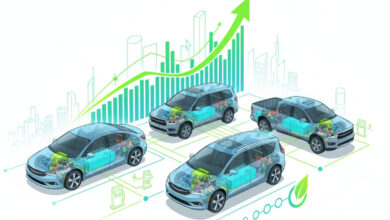Auto Dealership Consolidation Trends Challenge Dealers

Auto dealerships are changing, and not every business is keeping up. Smaller dealerships are struggling with deteriorating profit margins, aging systems, and increased competition contra larger, well-funded groups. It’s clear that the old model of running a dealership isn’t cutting it anymore.
Consolidation is becoming the go-to solution. By merging operations, dealerships can reduce costs, invest in digital tools, and offer better services to customers. As the saying goes, the businesses that adapt are positioning themselves for long-term growth. Today, we will break down everything about the auto dealership consolidation trends and why it matters for the future of automotive retail.
Auto Dealership Consolidation Continues to Rise
If you have driven around your town lately, you might have noticed a change. The local, family-owned car dealership you have known all your life may now be adorned with a new larger corporate name on the sign. It is not just occurring in your town but it is also a national trend. The auto dealership industry, once a fragmented landscape of independent businesses, is rapidly consolidating.
The data paints a clear picture of this shift. Over the last decade, the number of independent dealerships has lowered significantly. In exchange, there’s a massive increase in large auto dealerships, with the top 150 groups now controlling 30% of the entire market.
It’s not even slowing down. In fact, 2024 was the fourth-busiest year on record for dealership mergers and acquisitions (M&A), with 510 dealership rooftops changing hands. The stakes are incredibly high. The average “blue sky value” of a dealership—the premium paid above the hard assets for the franchise and goodwill—reached $20.9 million in 2024. Although this represents a decline of the 2023 high, it is still an incredible 122% above the 2019 levels before the pandemic.
Such consolidation wave, estimated to be a $100 billion opportunity, is not just a passing phase. It reflects a fundamental transformation in how cars are sold, financed, and serviced in America. So what is causing all this huge transformation? It boils down to a perfect storm of financial pressures, a digital arms race, and the costly challenges of a legacy business model.
Key Drivers Behind the Consolidation Trend
A. Financial Pressures
The first major driver is money, but not in the way you might think. On the surface, dealerships are incredibly profitable. The average dealership profit hit $4.1 million in 2024. Such high profitability makes dealerships attractive acquisition targets for buyers seeking stable cash-flow assets.
But the source of that profit is now dangerously complicated.
The profit from an actual new-car sale has become razor-thin, with average gross margins sitting at 5-7%. Used cars are better, at 12-15%, but the real money is made after the handshake.
The two most critical profit centers are Finance & Insurance (F&I) and Service & Parts. The F&I department alone, which handles loans and sells add-on products, now generates an average of $2,515 per vehicle. This single department contributes 30-40% of a dealership’s total gross profit. Even more important is the service bay. Service Parts department makes close to 50-55% of the gross profit of dealerships.
Here is a complicated profit mix in which scale becomes an enormous strength. A large dealer group can have a team of F&I experts, centralized training, and sophisticated processes to maximize profit on every deal. They can afford to lose money on a new car sale because they have perfected the art of service retention and financing. An independent dealer, on the other hand, struggles to compete on all these fronts simultaneously.
B. Digital Transformation
Today’s car-buying journey no longer starts on the lot. It starts on a smartphone. A full 92% of consumers conduct extensive online research before ever visiting a dealership. The global online car buying market is already valued at $370.70 billion and is growing.
This shift demands a massive technological investment. Customers expect a seamless “omnichannel” experience, where they can move from online research to an in-person test drive without friction.
Such digital infrastructure is incredibly expensive to build and maintain. A large, consolidated group can deploy a single, powerful digital platform across dozens of stores, spreading the cost. Whereas, an independent dealer simply cannot compete with that level of investment.
Also Read: How AI is Changing the Way We Maintain Our Cars
C. Legacy Challenges
The final driver is the immense cost and challenge of updating a legacy business model for the electric future. The rise of electric vehicles (EVs) represents an existential challenge for many traditional dealers.
First, there is the upfront cost. To sell and service EVs, a dealership must invest heavily in new infrastructure. This includes installing charging stations and purchasing specialized diagnostic equipment and tools, an investment that can range from $50,000 to $200,000 per location.
Second is the skills gap. Technicians require specialized training, often 40-80 hours of coursework, to safely work on high-voltage systems. Recruiting and retaining these EV-qualified technicians is a significant challenge.
Third, and perhaps most threatening, is the long-term impact on the business model. EVs require far less routine maintenance. There are no oil changes, and regenerative braking means brake replacements are less frequent. This directly attacks the Service & Parts department, the dealership’s most profitable area.
Impact of Consolidation on the Market
A. Changing Ownership Patterns
The buyers driving this auto retail industry consolidation are not who you might expect. The large, publicly-traded consolidators (like AutoNation and Penske) have actually slowed their spending, with US acquisitions dropping 91% year-over-year in Q1 2025.
The real action is with private buyers, who accounted for 95% of transactions. The most active acquirers are smaller, privately-owned dealer groups looking to become regional powerhouses. We are also seeing a new class of buyers: family-owned groups backed by private equity and family offices.
These new owners are not just buying dealerships at random. They are practicing “geographic clustering,” acquiring multi-store auto dealerships in the same market.
B. Opportunities for Buyers
For these acquiring groups, consolidation is a massive opportunity. The primary goal is to leverage economies of scale. By centralizing functions like human resources, accounting, and advertising, they can dramatically cut costs.
Buyers can be highly strategic in their acquisitions. They can pay a premium for high-performing, stable franchises like Toyota and Lexus, which command high valuations due to consistent profitability. Alternatively, they can hunt for bargains, acquiring dealerships with struggling brands like Nissan or some Stellantis franchises at a discount, confident that their superior operations can turn a profit.
C. Challenges for Smaller Players
For the independent, single-store dealers left behind, the environment is becoming incredibly difficult. They now face direct competition from well-capitalized, highly-efficient groups that can out-spend them on technology, advertising, and facilities.
These smaller players struggle to match the digital sophistication and speed of their larger rivals. They are also the most vulnerable to the high costs of the EV transition.
However, this trend is not entirely negative for them. For dealership owners reaching retirement age, the consolidation wave provides a golden “exit opportunity”. They can sell their life’s work for a transformative sum, capitalizing on blue sky values that are still far above historical norms.
Also Read: Auto Insights 2025: Streamlining Business Operations
Broader Trends and Implications
A. Automaker Consolidation
This entire trend at the dealership level is mirrored by a similar, and perhaps even more significant, trend at the manufacturer level. The late Sergio Marchionne, the former CEO of Fiat Chrysler, argued over a decade ago that the global auto industry’s setup was “unsustainable” and required consolidation to be financially viable.
His vision has proven true. We have already seen the massive merger of Fiat Chrysler and PSA Peugeot to form Stellantis. The source material even points to the potential for a future Honda-Nissan merger.
It matters because when automakers merge, they “rationalize” their dealer networks. Which means closing overlapping stores and forcing their franchised dealers to consolidate, which would trigger yet another wave of dealership M&A.
B. Political and Economic Factors
The dealership market does not exist in a vacuum. It is heavily influenced by government policy and the global economy.
➜ Regulations: The expiration of the $7,500 federal EV tax credit on September 30, 2025, is a major disruption. It drove a record-breaking surge in EV sales in Q3 2025 (438,487 units), but its absence creates significant uncertainty for 2026.
➜ Trade: Universal tariffs on imported vehicles and high tariffs on Chinese automakers limit market entry in the US, protecting domestic dealers but potentially increasing prices.
➜ Economy: In Europe, the market is facing headwinds from stagnant economic growth and intense competition from cheaper Chinese EV brands. In the US, the Federal Reserve’s interest rate policies directly impact vehicle affordability and, in turn, dealership profitability.
C. Future Growth Areas
As these new, larger dealership groups form, their focus will shift to the most profitable and fastest-growing parts of the business. Thus, the future of auto retail will be defined by three key areas:
- Used Cars: With higher margins than new cars, the used market is a top priority. Certified Pre-Owned (CPO) programs are growing, and the global used car market is projected to reach an astounding $2.70 trillion by 2030.
- Online Buying: Probably the fastest-growing channel. The online car buying market is projected to grow at 12.7% CAGR. The groups that perfect the digital-to-physical handoff will win.
- Service and Loyalty: This remains the single most important long-term play. With service and parts driving nearly half of all profit, customer retention is everything. The data shows acquiring a new customer costs 5 to 7 times more than retaining an existing one. The new battlefield is not the showroom. It is the service drive, where loyalty programs, transparent communication, and digital tools create customers for life.
Winning on that battlefield requires a different kind of leadership and a new set of rules. If you’re ready to stop guessing and start dominating the service drive, it’s time to get the right playbook. Champion the systems that create profit at Chris Collins Inc., build the mindset with the I Am Leader book, and find more essential resources at the Syndicate Library.
Conclusion
Auto dealership consolidation trends aren’t just reshaping the industry—they’re creating opportunities for those who act quickly and strategically. With the market constantly changing, being ahead of the pack requires knowing the effects of consolidation on businesses, buyers, and competition. If this caught your attention and gave you a fresh perspective, share this article with someone who would find it useful too. Together, we can keep the conversation going.
—
Author: Maverick Steel is a writer and digital marketer who enjoys connecting the dots for strategy and engaging content. He spent 6 years in secondary education as a proud campus journalist, specializing in editorial and column writing. Holding a bachelor’s degree in Marketing Management, Maverick is also a devoted advocate for positive cyber citizenship and a certified pet lover. When he’s not busy writing, you can catch him hitting the gym or enjoying a matcha latte at the nearest aesthetic coffee shop.



